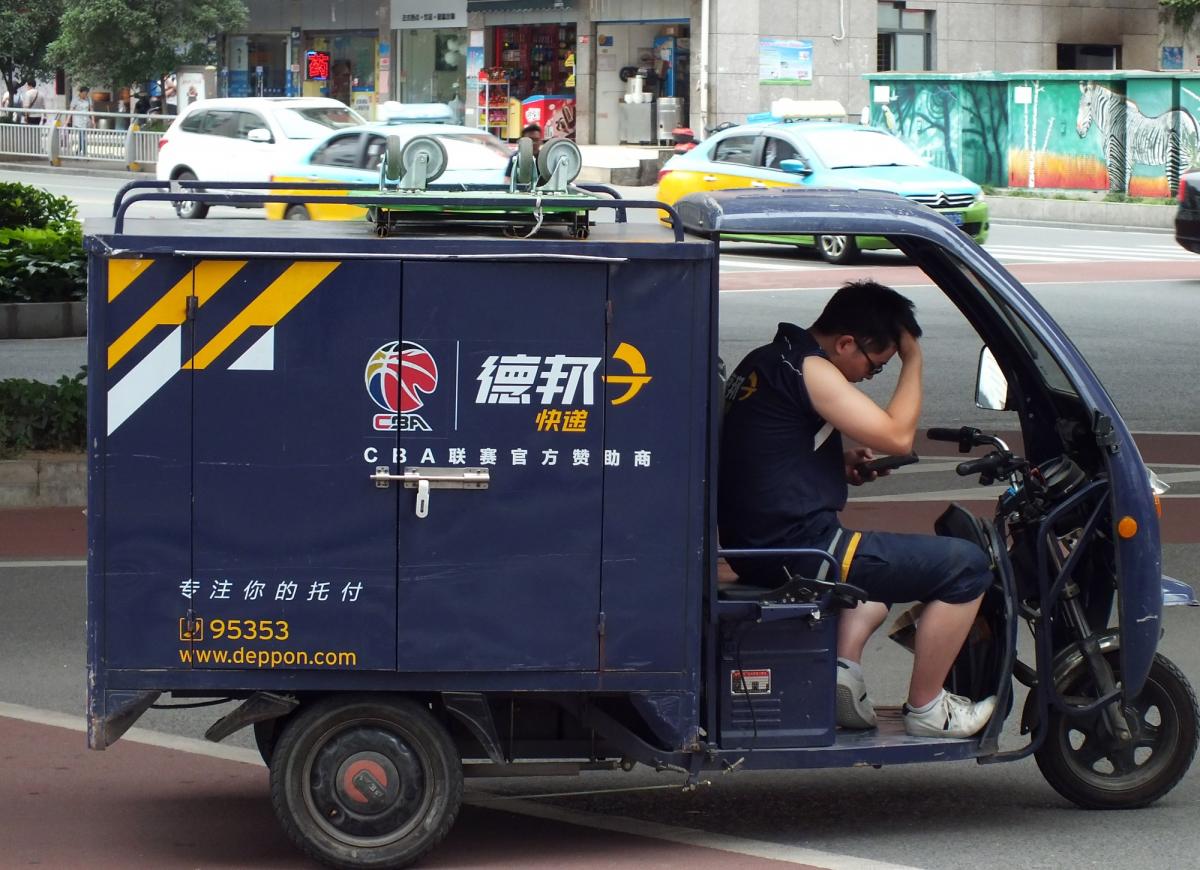For China’s couriers, not all routes are created equal
16 March 2021Intense competition among express delivery companies in China has led to a string of bankruptcies over the last few years, with smaller companies going out of business and workers owed wages in arrears.
At the same time, those couriers who still have a job face increasing pressure to keep up with the growing volume of orders. Courier Zhang Mingming, for example, says he was delivering around 150 parcels a day two years ago. That number has since doubled to 300. And last November during Singles Day, China’s largest online shopping festival, Zhang had to deliver a staggering 400 parcels per day, a physically impossible target.
Zhang said he had to leave home at 6:00 am and spend more than an hour sorting and loading parcels at the distribution centre. He managed to deliver about 80 parcels by midday, but then had to return to the distribution centre to begin the whole process again.
Couriers’ pay is linked directly to the number of orders they fulfil each day, so higher targets should in theory translate into higher pay. However, compensating workers by volume ignores the simple truth that not all routes are created equal.

The delivery industry’s payment structure rewards long-time workers who operate in more densely populated areas and are familiar with routes and customers. Their knowledge and the comparatively more friendly geography of the areas they service means that they can minimise time spent fulfilling each order. These couriers can earn 7,000 to 8,000 yuan a month.
However, according to a new survey by China Post, more than half of China’s couriers have a monthly income of no more than 5,000 yuan, and only 1.3 percent have an income in excess of the 10,000 yuan per month figure frequently touted by the industry. About 40 percent of the predominantly young workforce deliver fewer than 100 items each day, and 80 percent deliver no more than 200 items per day.
New couriers are on the lowest rung of the ladder. They are usually allocated routes in remote suburban and rural areas in order to increase the platforms’ reach and revenue. They must use their instincts and ingenuity to design the most time-efficient routes, says Zhang Yangbo, associate professor at Wuhan University and author of Familiar Strangers: The Daily Routine and Work of Couriers. Some interviews which Zhang conducted are quoted below.
The success of delivery companies relies on this extra and often unacknowledged labour. As the frontline representatives of delivery companies, couriers build relationships with customers, often messaging them directly on WeChat. When faced with customers who are not familiar with ordering, or who fill in incorrect information, the workers have to devote time to explaining how the platform works and accounting for errors.
In addition to navigating unfamiliar terrain, new couriers face lower salaries and higher work pressure. Their customers are geographically dispersed and road conditions are often poor. Buildings may not be numbered consecutively, which makes planning routes difficult. “It’s what we fear most,” says courier Wang Can. “We waste a lot of time.”
Another courier, Liu Wenduan, explained, “If I have a lot of parcels to pick up, I’ll design my route according to pick-up locations and deliver parcels afterwards. I really don’t like running the same route again.”
Poor work conditions paired with low remuneration mean that new couriers often vote with their feet, leaving within a few days or months. There is often little solidarity between new and longtime employees. Experienced couriers tend to think that they have a better deal and do not see the need for collective bargaining nor standing in solidarity with newer members of the courier workforce. So far, couriers have not participated in large-scale collective action over pay and conditions. Protests do occur but are usually related to workers’ demands for payment of wages in arrears when stations go bankrupt, which is a frequent occurrence in this cutthroat business.
Other developments like the emergence of Alibaba’s Cainiao pick-up stations seem to make the delivery process easier by holding the customer, not the courier, responsible for the last leg of the delivery process. But this may lead to companies hiring fewer workers to deliver the same volume of parcels or hiring new workers on lower salaries.
These trends suggest that experienced couriers may start to feel the heat soon. Platforms have shown no signs that they will cut down on the workload of couriers, and innovations like pick-up stations do not translate into better pay or working conditions.
A new collective contract for couriers in Beijing includes health and safety provisions, such as health checkups, work injury insurance, safety guarantees and vocational skills training. However, work hours and fines meted out by the platform still lie outside the contract’s scope. Couriers will need to apply pressure on trade unions to expand the scope of labour protections. While they already have informal networks, couriers need an organisation within which they can aid each other and formulate clear, collective demands.
